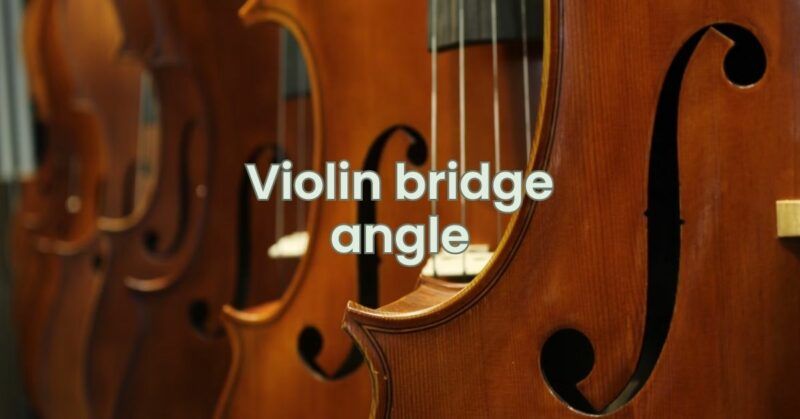The violin bridge angle plays a crucial role in determining the instrument’s playability, sound projection, and tonal quality. As a delicate component positioned between the violin’s soundboard and strings, the bridge transmits the vibrations of the strings to the body of the instrument, ultimately creating its beautiful sound. Achieving the correct bridge angle is essential for optimal sound production and violin performance. In this comprehensive guide, we will explore the significance of the violin bridge angle and its impact on the instrument’s playability and tone.
What is the Violin Bridge Angle?
The violin bridge angle refers to the degree at which the bridge is positioned relative to the violin’s top plate. This angle influences various aspects of the violin’s performance, including string height, tonal quality, and ease of playing. When correctly set, the bridge angle ensures that the strings have sufficient clearance from the fingerboard, allowing for easy fingering and bowing without buzzing or unwanted noise.
Factors Influencing the Bridge Angle:
- String Height: The bridge angle directly affects the height of the strings above the fingerboard. Proper string height is crucial for comfortable playing and accurate intonation. A well-adjusted bridge angle ensures that the strings are not too high, making it challenging to press them down, or too low, causing buzzing and muted tones.
- Sound Projection: The angle of the bridge influences how the sound vibrations are transmitted to the violin’s top plate. An optimal bridge angle allows the sound to be projected effectively, resulting in a clear and resonant tone.
- Tonal Quality: The bridge angle can significantly impact the tonal quality of the violin. A well-balanced angle ensures that all strings have equal volume and tonal richness, contributing to a balanced and harmonious sound across the instrument’s entire range.
- Bowing Technique: The bridge angle also affects bowing technique. An angle that is too steep or shallow may cause difficulties in bowing smoothly across the strings, affecting the player’s ability to produce a consistent and even sound.
How to Set the Violin Bridge Angle:
- Consult a Professional: Adjusting the bridge angle is a delicate process that requires experience and precision. If you are uncertain or inexperienced in this area, it is best to seek assistance from a professional violin luthier or an experienced violin instructor.
- Check String Height: Before adjusting the bridge angle, ensure that the strings have the appropriate height above the fingerboard. Use a ruler or a specialized tool to measure the distance between the strings and the fingerboard. Make necessary adjustments to the bridge height if needed.
- Align the Bridge: Position the bridge between the soundholes, ensuring that the feet of the bridge are aligned with the notches carved into the violin’s top plate. Use a bridge setter or a pencil to guide you in placing the bridge upright and perpendicular to the instrument’s body.
- Check the Angle: Observe the bridge angle from the side of the instrument. The bridge should have a slight backward tilt, with the tailpiece side slightly higher than the fingerboard side. This angle allows for the proper clearance between the strings and the fingerboard.
- Test Playability and Sound: After adjusting the bridge angle, carefully tune the violin and test its playability and sound. Pay attention to ease of fingering, bowing, and the overall tonal quality. Make any fine adjustments as necessary to achieve the desired outcome.
Conclusion
The violin bridge angle is a critical element that significantly impacts the instrument’s playability, sound projection, and tonal quality. A well-set bridge angle ensures comfortable playing, clear sound projection, and a harmonious tone across all strings. Achieving the correct bridge angle requires precision and expertise, making it essential to seek assistance from a qualified violin luthier or instructor if you are unsure about the adjustment process. With proper care and maintenance, a well-adjusted bridge angle will contribute to the violin’s beauty and musical excellence, enriching your playing experience and captivating audiences with its resonant and captivating sound.


